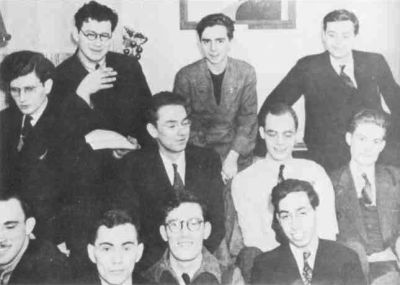Atomigeddon coda: the path not taken
“The Reunion at the Mile High”
By Frederik Pohl

3 Nov, 2014
0 comments
Frederik Pohl was many things: author, agent, editor, that guy who beat me for the 2010 Best Fan Hugo (James angrily shakes his fist). This short story, first published in 1989’s Foundation’s Friends: Stories in Honor of Isaac Asimov, combines a number of those interests.
Fair warning: spoilers.
“The Reunion at the Mile High” is framed as a nostalgia piece about a reunion of Futurians, a group of fans many of whom in real life became filthy pros and went on to shape modern science fiction. It becomes clear that the story is an alternate history when we are introduced to the hotel chosen for the reunion, a grand structure that our own New York never saw. Also, those in the know about the Futurians and their fates will spot faces that have no place in a story set as late as this one is; the Futurians had many gifts but longevity was not one of them.
The explanation for the presence of figures like Kornbluth turns out to lie in the point of departure that divided this world from our own. The world of the story went a few steps farther down the biotech pathway than we have as yet managed, while missing out on an entire clade of exciting technologies. Asimov, through no fault of his own, turns out to have played a pivotal role in the great project that ended the Pacific War. Asimov is lauded as one of history’s Great Men, leaving a gap in science fiction another Futurian was more than happy to fill.
Generally Pohl is a competent author and I enjoy his biographical reminiscences. I don’t especially enjoy this specific genre, where history is changed to cast this fan or that writer as a grand historical figure; probably proof that I am utterly humourless, but SF’s self-aggrandizing fantasies just embarrass me.
I don’t really see someone as self-admittedly abrasive as Asimov fitting all that well into a Manhattan-District-style war project. The friction between junior chemist Asimov and Heinlein at the Philadelphia Navy Yard is a matter of historical record; I cannot imagine what the consequences would have been like if he served under a security-obsessed officer like Groves.
From the perspective of the late 1980s, a world without nuclear weapons would seem pretty sweet … but I do have to wonder how many Japanese died from the weaponized typhus Asimov helped develop. Biological warfare is easy to turn on and hard to turn off, although DDT (known to this world) might have been of some use against typhus. The story explains that medicine has made great strides since WWII, which may hint that this world has its own dark arms race — in this case, between artificial pandemics and cures.
Sponsored by Raja Thiagarajan
